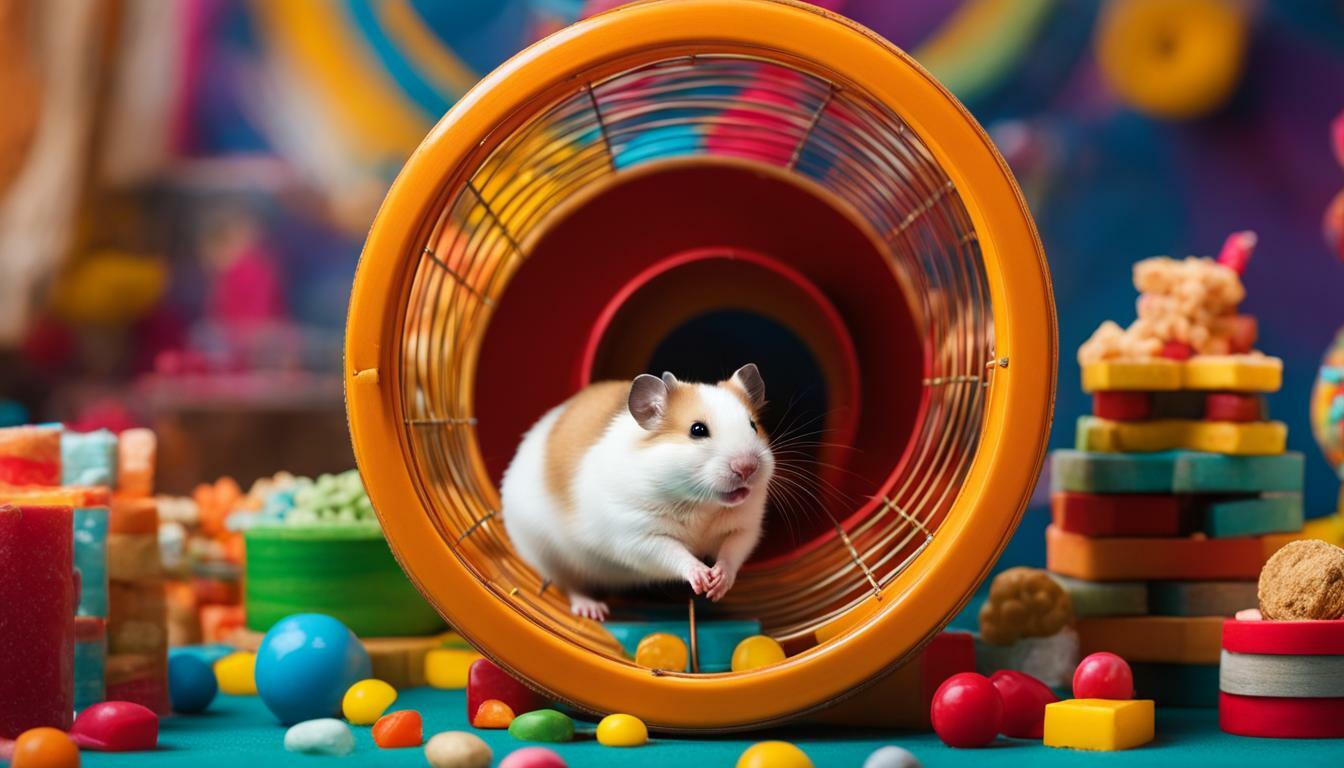Hamsters are known for their constant running, but have you ever wondered why they have such a strong urge to run? It turns out that hamsters have an innate need for exercise and running is a natural behavior for them. Their ancestors used to run away from predators, and this instinct has been passed down through generations. Running on a wheel not only helps hamsters release energy but also keeps them fit and maintains the health of their muscles and joints. Additionally, regular exercise on a wheel can prevent health problems like obesity and boredom in hamsters.
Key Takeaways:
- Hamsters have a natural instinct to run due to their ancestors.
- Running on a wheel helps hamsters release energy and stay fit.
- Regular exercise on a wheel prevents health problems like obesity and boredom.
- Providing a stable and safe wheel made of plastic is important for the well-being of hamsters.
- Hamster balls and flying saucers are alternative exercise options, but a wheel is more natural for hamsters.
Now that we understand the reasons behind hamsters’ constant running, it is important to choose the right wheel for optimal exercise and provide a stimulating environment with other toys and accessories. Stay tuned as we explore these topics further in the upcoming sections.
The Natural Need for Exercise
Hamsters are naturally energetic animals, and regular exercise is necessary for them to stay healthy and content. Running is an instinctive behavior that comes from their ancestors who used to run away from predators. In captivity, hamsters have high activity levels and need an outlet to fulfill their instinct to run.
A hamster wheel is an essential accessory for any hamster owner. Running on a wheel helps hamsters release pent-up energy, stay fit, and keep their muscles and joints toned. It also serves as a form of mental stimulation, preventing boredom and promoting overall well-being.
It is important to choose the right wheel for your hamster. Opt for a stable and safe wheel, preferably made of plastic, with spokes that are not too close together to avoid any potential injuries. The size of the wheel should also be appropriate for your hamster’s breed. For dwarf hamsters, a minimum wheel size of 6.5 inches is recommended, while Syrian hamsters should have a wheel size of at least 8 inches. A properly sized wheel ensures that your hamster can run comfortably without straining or injuring itself.
In addition to a running wheel, there are other exercise options available for hamsters. Hamster balls and flying saucers provide an alternative way for hamsters to move and explore their surroundings. These options allow for supervised exercise outside of the cage. However, it is important to note that a wheel is a more natural and preferred method for hamsters to fulfill their need for exercise.
Enriching the Environment
Providing a stimulating environment for your hamster is crucial to keeping it engaged and active. Alongside a running wheel, you can introduce various toys and accessories such as tubes, ladders, and tunnels. These additions not only provide opportunities for physical activity but also serve as enrichment, encouraging exploration and playtime. Mixing up the cage setup periodically and introducing new toys can prevent boredom and promote mental stimulation for your furry friend.
| Exercise Options | Benefits |
|---|---|
| Running Wheel | Helps release energy, keeps muscles and joints toned, prevents obesity and boredom |
| Hamster Balls and Flying Saucers | Alternative exercise options for supervised movement and exploration |
| Tubes, Ladders, and Tunnels | Provide additional physical activity and mental stimulation |
In conclusion, regular exercise is vital for a hamster’s physical and mental well-being. Running on a wheel fulfills their natural instinct to run and helps them stay happy and healthy. Alongside a suitable wheel, providing a stimulating environment with toys and accessories can further enrich their lives. Remember to choose the right size wheel, mix up their surroundings, and introduce new toys to keep your hamster engaged and content.
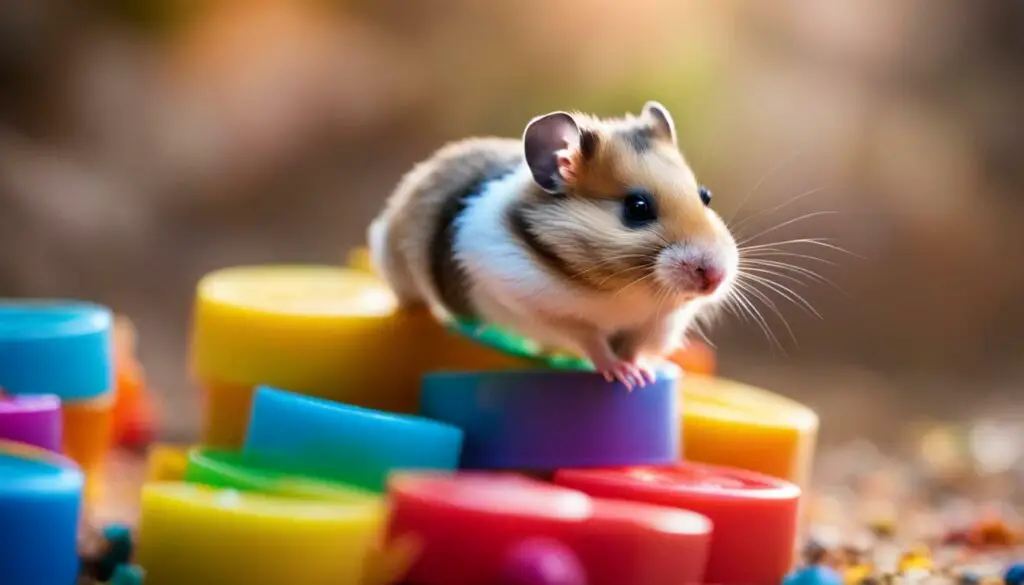
To understand why hamsters run so much, it’s important to first understand their behavior patterns. Hamsters are naturally active and curious creatures, with a high energy level that needs to be channeled. In the wild, hamsters have a strong instinct to run and explore in order to find food and avoid predators. This innate behavior has carried over to domesticated hamsters, and a lack of exercise can lead to boredom and even health problems.
Hamsters have a natural need for exercise to release their pent-up energy and to keep their muscles and joints toned. Running on a wheel is one of the primary ways for hamsters to fulfill this instinctual drive. It allows them to engage in their natural behavior within the limited space of a cage or enclosure. Regular exercise on a wheel not only helps hamsters stay fit, but it also provides mental stimulation, preventing boredom and promoting overall well-being.
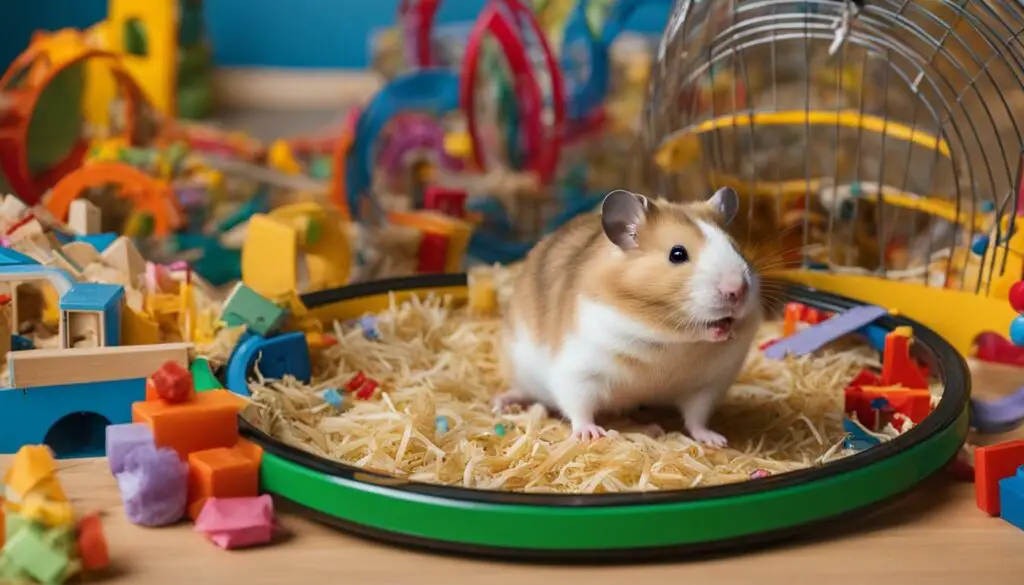
Choosing the right wheel is crucial for the hamster’s safety and comfort. It should be stable and securely attached to the cage, preferably made of plastic to prevent any potential injuries. The spokes of the wheel should not be too close together, to avoid the risk of the hamster getting trapped or injured. It’s important to select a wheel that is appropriately sized for the hamster’s breed. Dwarf hamsters, for example, require a minimum wheel size of 6.5 inches, while Syrian hamsters need a wheel that is at least 8 inches in diameter.
In addition to running wheels, there are other alternative exercise options for hamsters, such as hamster balls and flying saucers. However, a wheel is a more natural and preferred method for hamsters to run. Providing a variety of toys and accessories like tubes, ladders, and tunnels can also keep hamsters entertained and active. Mixing up the cage setup and introducing new toys regularly can prevent boredom and encourage exploration.
“Hamsters have a natural need for exercise to release their pent-up energy and to keep their muscles and joints toned.”
| Type of Toy | Benefits |
|---|---|
| Running Wheel | Fulfills hamsters’ instinctual need to run, helps them stay fit and mentally stimulated |
| Hamster Ball | Allows hamsters to explore outside their cage while keeping them contained |
| Flying Saucer | Provides a spinning platform for hamsters to run on without the need for a wheel |
| Tubes, Ladders, and Tunnels | Offers additional opportunities for hamsters to climb, hide, and explore |
In conclusion, hamsters are natural runners, and it’s important to provide them with the means to fulfill this instinctual behavior. Running on a wheel not only helps hamsters release energy, stay fit, and keep their muscles and joints toned, but it also prevents health problems and promotes mental well-being. By understanding hamster behavior and providing suitable exercise options, such as running wheels and other stimulating toys, you can keep your furry friend happy, healthy, and entertained.
The Importance of Running Wheels
Hamster wheels play a crucial role in fulfilling a hamster’s exercise needs, providing them with an outlet for their energy. Running on a wheel is a natural behavior for hamsters, stemming from their ancestors’ instinct to run away from predators. It allows hamsters to release pent-up energy, stay fit, and keep their muscles and joints toned. Additionally, regular exercise on a wheel helps prevent health problems like obesity and boredom.
Hamsters have high energy levels and an innate drive to run, making a hamster wheel an essential component for their physical and mental well-being. When selecting a wheel, it is important to choose one that is stable and safe, preferably made of plastic, with spokes that are not too close together. This ensures that your hamster can comfortably and securely run without the risk of injury.
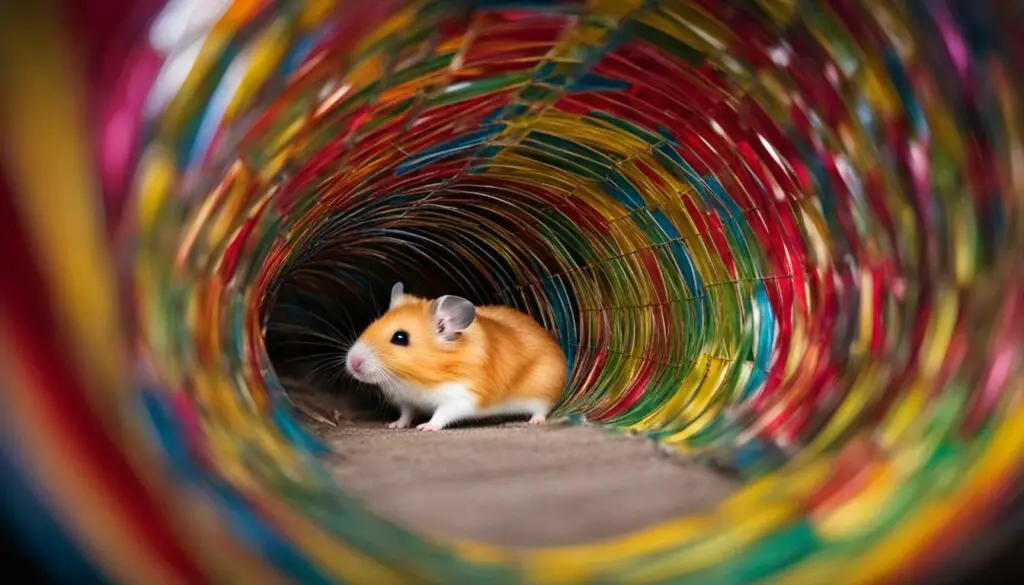
While hamster balls and flying saucers are alternative exercise options, a wheel is a more natural choice for hamsters. It allows them to engage in their instinctual running behavior, simulating their natural habitat. To further enrich their environment, providing other toys like tubes, ladders, and tunnels can keep hamsters entertained and promote additional physical activity.
Choosing the right wheel size
The size of the wheel is also crucial to ensure your hamster’s comfort and safety. For dwarf hamsters, a minimum wheel size of 6.5 inches is recommended, while Syrian hamsters should have a wheel size of at least 8 inches. It’s important to consider your hamster’s breed and size when choosing a wheel to prevent any potential injuries or discomfort.
By incorporating a hamster wheel into your furry friend’s habitat, you are providing them with a vital means of exercise and mental stimulation. Mixing up the cage setup and introducing new toys can also help keep hamsters engaged and prevent boredom. Remember, running on a wheel is more than just physical activity for hamsters – it is a natural and important part of their overall well-being.
Preventing Health Problems
Regular exercise can contribute to a hamster’s overall well-being and prevent health problems like obesity and boredom. Running on a wheel is a natural behavior for hamsters, allowing them to release energy, stay fit, and keep their muscles and joints toned. It is essential to provide a stable and safe wheel for your furry friend, preferably made of plastic with spokes that are not too close together. A suitable running wheel is an important investment in your hamster’s physical and mental health.
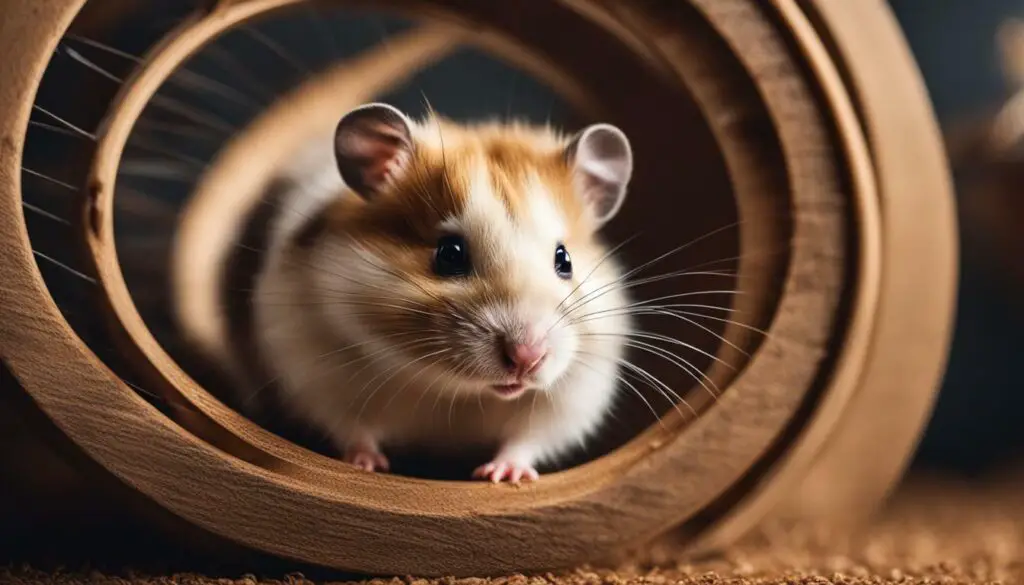
In addition to a running wheel, there are other exercise options available for hamsters, such as hamster balls and flying saucers. However, a wheel is a more natural way for hamsters to fulfill their instinct to run. These alternative options may be suitable for short periods of time or supervised play, but a wheel provides continuous exercise opportunities.
Creating a stimulating environment is also crucial for keeping hamsters active and entertained. Alongside a running wheel, introduce toys like tubes, ladders, and tunnels to encourage exploration and engagement. Mixing up the cage setup regularly and introducing new toys can help prevent boredom and keep your hamster mentally stimulated.
Choosing the Right Wheel Size for Your Hamster
| Hamster Breed | Minimum Wheel Size |
|---|---|
| Dwarf Hamsters | 6.5 inches |
| Syrian Hamsters | 8 inches |
When selecting a running wheel for your hamster, it is important to consider the appropriate size based on their breed. For dwarf hamsters, a minimum wheel size of 6.5 inches is recommended, while Syrian hamsters require a larger wheel with a minimum size of 8 inches. Providing a properly sized wheel ensures that your hamster can run comfortably without risking injury.
In summary, regular exercise on a running wheel is vital for a hamster’s physical and mental well-being. It helps prevent health issues like obesity and boredom, releases energy, and keeps their muscles and joints in good condition. Alongside a running wheel, offering alternative exercise options like hamster balls and flying saucers, as well as providing a stimulating environment with toys and accessories, can keep your hamster happy, healthy, and entertained.
Choosing the Right Wheel
When choosing a hamster wheel, it’s essential to prioritize stability, safety, and the material of the wheel. Hamsters rely on their running wheel as a primary form of exercise, so it’s crucial to provide them with a wheel that meets their needs and keeps them safe.
Firstly, stability is key. Look for a wheel that has a solid base and is securely attached to the cage. A wobbly or unstable wheel can cause accidents and injuries to your hamster. Additionally, make sure that the wheel is the appropriate size for your hamster’s breed. Dwarf hamsters typically require a wheel with a minimum diameter of 6.5 inches, while Syrian hamsters need a larger wheel of around 8 inches or more.
Safety is another important consideration. Avoid wheels with bars or spokes that are too close together as this can lead to potential injuries such as broken limbs or trapped feet. Opt for a wheel made of sturdy plastic material that is smooth and free from sharp edges. This will minimize the risk of any harm to your furry friend.
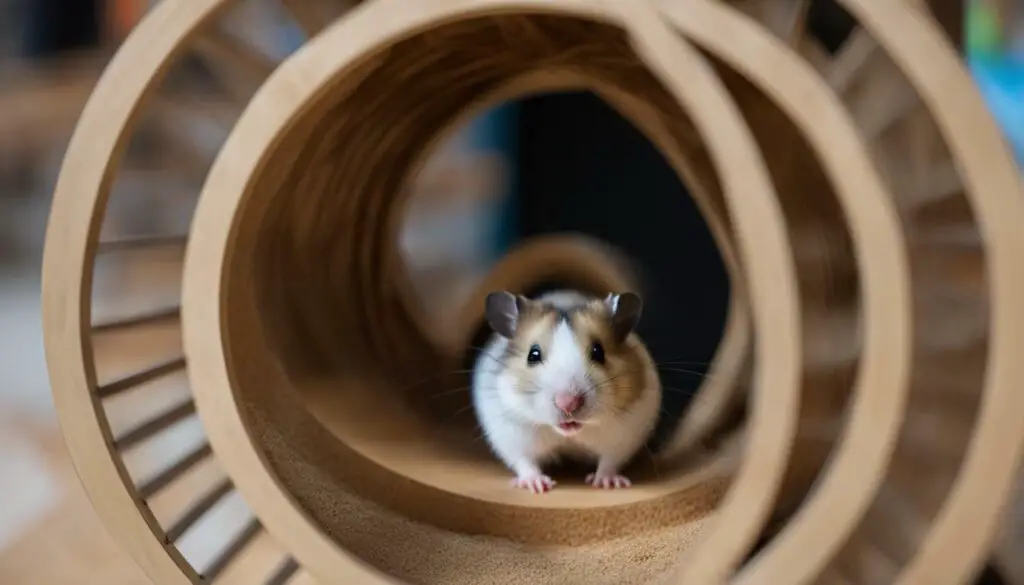
Lastly, consider the needs and preferences of your hamster. Some hamsters may prefer a closed wheel design, while others may enjoy an open wheel that allows for easy entry and exit. Observe your hamster’s behavior and choose a wheel that suits their preferences.
| Size | Recommended for |
|---|---|
| 6.5 inches | Dwarf hamsters |
| 8 inches or more | Syrian hamsters |
Remember, providing your hamster with a suitable running wheel is essential for their physical and mental well-being. It allows them to fulfill their natural instinct to run and helps prevent health problems caused by lack of exercise.
Alternative Exercise Options
While running wheels are the most common form of exercise for hamsters, there are other options to consider. These alternatives can provide variety and enrich your hamster’s physical and mental stimulation.
Hamster balls are a popular choice for allowing your furry friend to explore beyond their cage. These clear plastic balls provide a safe and secure environment for your hamster to roam freely while you supervise. The ball allows them to exercise their natural instinct to explore and can be used both indoors and outdoors.
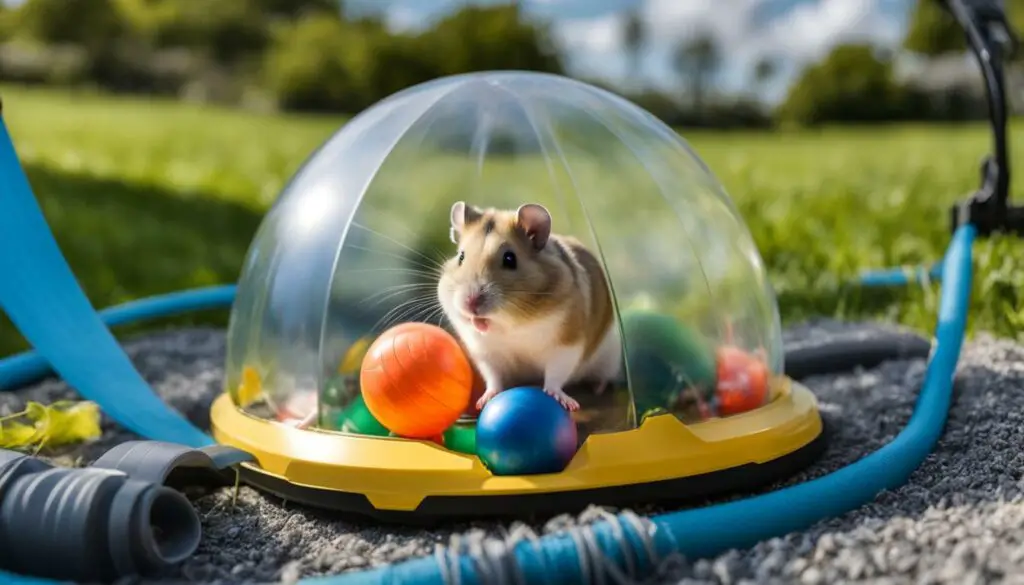
Flying saucers are another option that offers a different type of exercise. These colorful plastic discs allow your hamster to run in a circular motion, simulating their natural running behavior. They provide a fun and interactive experience for your hamster while keeping them active and engaged.
Choosing the Right Exercise Option for Your Hamster
When considering alternative exercise options for your hamster, it’s important to take into account their size, breed, and preferences. Some hamsters may prefer one option over the other, so it’s essential to observe their behavior and adapt accordingly. Remember to always supervise your hamster during exercise activities to ensure their safety.
| Exercise Option | Description | Benefits |
|---|---|---|
| Hamster Ball | A clear plastic ball that allows your hamster to roam freely. | Exploration, exercise, and mental stimulation. |
| Flying Saucer | A colorful plastic disc that simulates running in a circular motion. | Active play, physical exercise, and engagement. |
By offering alternative exercise options like hamster balls and flying saucers, you can provide your furry friend with a varied and stimulating environment. Remember to always prioritize their safety and well-being when introducing new exercise equipment.
Enriching the Environment
In addition to exercise equipment, providing a variety of toys and accessories can keep hamsters entertained and active. Hamster toys, such as tunnels, ladders, and tubes, offer a fun and stimulating environment for your furry friend. These toys encourage exploration and mimic the natural burrowing behavior of wild hamsters.
A hamster tunnel system, for example, can provide endless hours of entertainment as your hamster scurries through the interconnected tubes. This not only keeps them physically active but also provides mental stimulation. Hamsters love to climb, so adding a ladder or two to their cage allows them to exercise their climbing instincts.
By introducing different toys and accessories, you can create a dynamic and engaging environment for your hamster. They will have opportunities for play, exploration, and exercise, reducing the risk of boredom and promoting a happier, healthier pet.
| Toy | Description |
|---|---|
| Hamster Tubes | A network of interconnected tubes that allow your hamster to scurry and explore. |
| Hamster Ladders | A climbing accessory that allows your hamster to exercise their natural climbing instincts. |
| Hamster Tunnels | A spacious tunnel system that provides a fun and stimulating environment for your hamster to explore. |
Remember to regularly clean and inspect these toys for any signs of wear or damage. Always provide a safe and secure environment for your hamster to prevent accidents or injuries.
Hamster Quote of the Day:
“Toys and accessories not only keep me entertained but also fulfill my natural instincts. I love exploring tunnels and climbing ladders!” – Fluffy, the Hamster
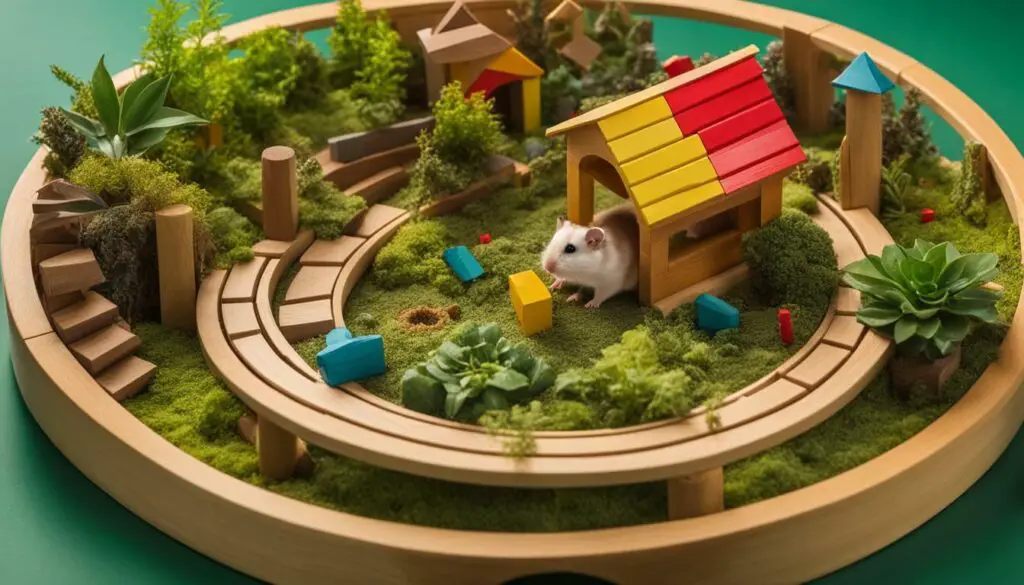
By providing a range of toys, like tunnels, ladders, and tubes, you can enrich your hamster’s environment and keep them active and happy. Remember to choose toys that are suitable for your hamster’s size and breed, and regularly rotate them to keep things interesting. With a stimulating environment and plenty of exercise options, your hamster will lead a fulfilling and joyful life.
Proper Wheel Size for Different Breeds
It’s crucial to choose a wheel size that suits the breed of your hamster to ensure comfortable and safe exercise. Hamsters come in different sizes, and their wheel should accommodate their unique needs. For dwarf hamsters, a wheel with a minimum diameter of 6.5 inches is recommended. This size allows them to run without their backs arching, reducing the risk of injury. Syrian hamsters, being larger in size, require a minimum wheel size of 8 inches. This ensures that they have enough space to run freely without their bodies being cramped.
When selecting a wheel, pay attention to its construction and materials. Opt for a stable and sturdy wheel made of plastic. This will prevent any wobbling or instability while your hamster is running. Additionally, choose a wheel with spokes that are not too close together to prevent the possibility of injury. A well-designed wheel will provide a safe and enjoyable exercise experience for your furry friend.
Creating a stimulating environment for your hamster goes beyond just providing the right wheel size. Consider adding various toys and accessories to keep them entertained and active. Tubes, ladders, and tunnels can be great additions to their cage, allowing them to explore, climb, and exercise different muscles. Mixing up the cage setup and introducing new toys regularly can help prevent boredom and keep your hamster engaged.
To summarize, choosing the proper wheel size for your hamster is essential for their well-being. Both dwarf and Syrian hamsters have specific requirements when it comes to wheel size, and providing them with a suitable wheel ensures comfortable and safe exercise. Remember to select a stable and plastic wheel with appropriate spacing between spokes. Don’t forget to enrich your hamster’s environment with additional toys and accessories to keep them mentally and physically stimulated. With the right wheel and a stimulating environment, your hamster will be able to enjoy their natural instinct to run, leading to a happy and healthy life.
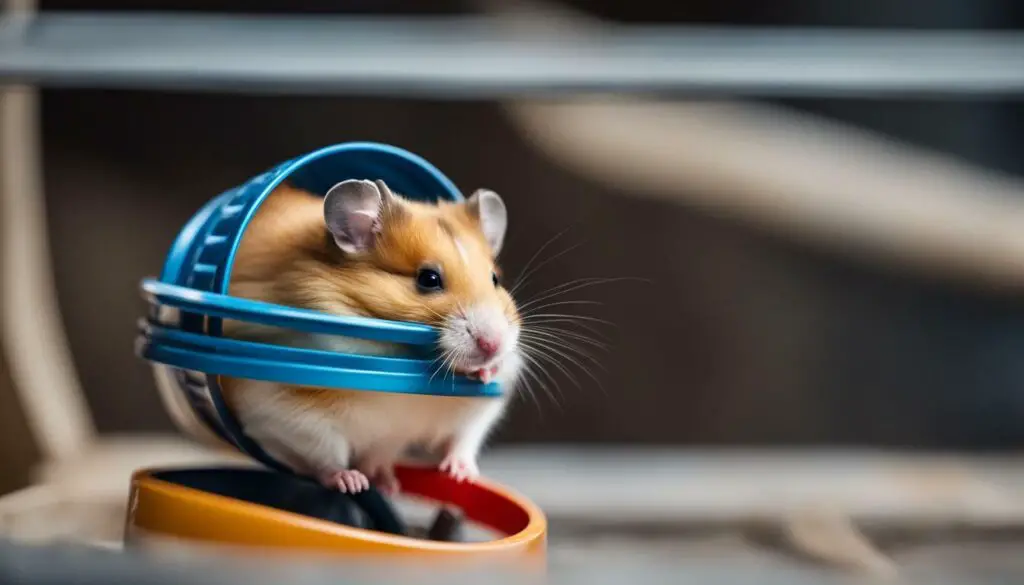
Regular exercise, through the use of running wheels and other suitable options, is essential for maintaining the well-being of hamsters. Hamsters love running on wheels because it is a natural behavior that comes from their ancestors who used to run away from predators. Running on a wheel helps hamsters release energy, stay fit, and keep their muscles and joints toned. It also prevents health problems like obesity and boredom.
Hamsters have high energy levels and need to fulfill their instinct to run, which is why a hamster wheel is essential for their physical and mental well-being. It is important to choose a stable and safe wheel, preferably made of plastic, with spokes that are not too close together. Hamster balls and flying saucers are alternative exercise options, but a wheel is a more natural way for hamsters to run.
Providing other toys like tubes, ladders, and tunnels can also keep hamsters entertained and active. The size of the wheel should be appropriate for the hamster’s breed, with a minimum size of 6.5 inches for dwarf hamsters and 8 inches for Syrian hamsters. Mixing up the cage setup and introducing new toys can help keep hamsters engaged and prevent boredom. Overall, running on a wheel is a natural and important activity for hamsters that helps keep them happy and healthy.
FAQ
Why do hamsters run so much?
Hamsters run a lot because it is a natural behavior that comes from their ancestors who used to run away from predators. Running helps them release energy, stay fit, and keep their muscles and joints toned.
What is the natural need for exercise in hamsters?
Hamsters have high energy levels and a natural drive to run. Exercise is essential for their physical and mental well-being. It helps fulfill their instinct to run and prevents health problems like obesity and boredom.
How does hamster behavior relate to their need for exercise?
Hamsters are active creatures and need to engage in physical activities to stay happy and healthy. Running is an instinctual behavior that allows them to release energy and fulfill their natural drive to explore and move around.
How important are running wheels for hamsters?
Running wheels are crucial for hamsters as they provide a natural and convenient way for them to run. A wheel allows hamsters to fulfill their exercise needs in a safe and enclosed environment, helping them stay fit both physically and mentally.
How does running on a wheel prevent health problems in hamsters?
Regular exercise on a running wheel helps hamsters maintain a healthy weight, preventing obesity. It also keeps their muscles and joints toned, reducing the risk of conditions like arthritis. Exercise also helps prevent boredom and behavioral issues that can arise from lack of stimulation.
What factors should be considered when choosing a hamster wheel?
It is important to select a stable and safe wheel, preferably made of plastic, with spokes that are not too close together. The size should be appropriate for the hamster’s breed, with a minimum size of 6.5 inches for dwarf hamsters and 8 inches for Syrian hamsters.
Are there alternative exercise options for hamsters?
Yes, hamster balls and flying saucers are alternative exercise options. However, running on a wheel is a more natural way for hamsters to run, as it allows them to control their speed and direction more comfortably.
How can the hamster’s environment be enriched?
Providing other toys like tubes, ladders, and tunnels can keep hamsters entertained and active. These accessories offer additional opportunities for exercise and exploration, promoting a stimulating environment for hamsters.
What is the proper wheel size for different hamster breeds?
The wheel size should be appropriate for the hamster’s breed. Dwarf hamsters require a minimum wheel size of 6.5 inches, while Syrian hamsters need a minimum of 8 inches in diameter for comfortable running.
What is the importance of exercise for hamsters?
Exercise is crucial for hamsters’ physical and mental well-being. It helps them release energy, stay fit, and prevent health problems. Regular exercise also keeps hamsters entertained and engaged, preventing boredom and promoting a happy and healthy life.

